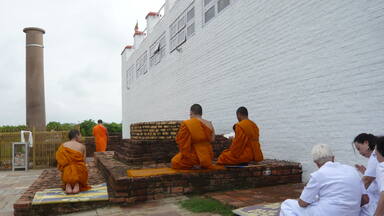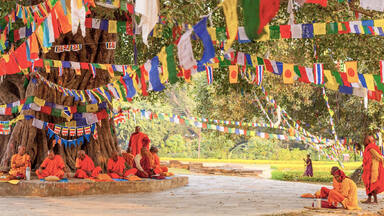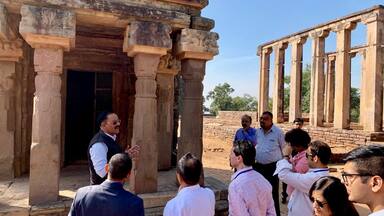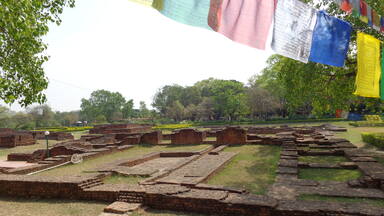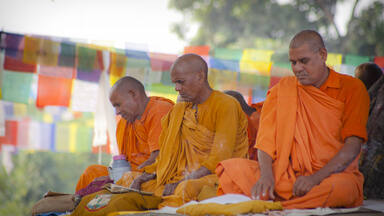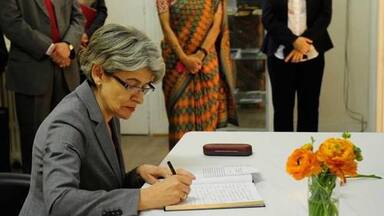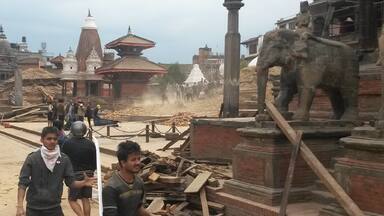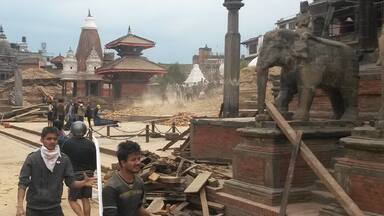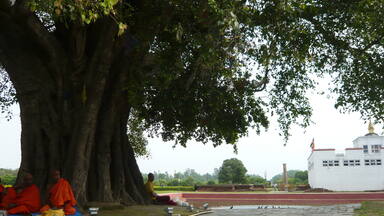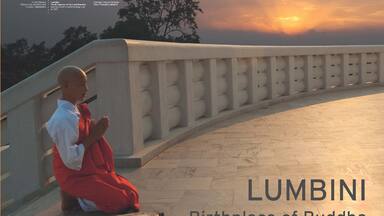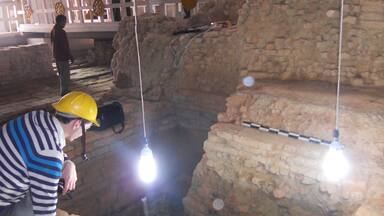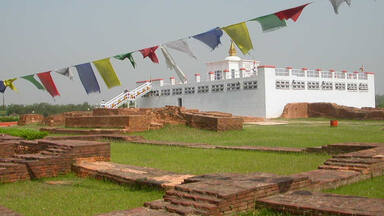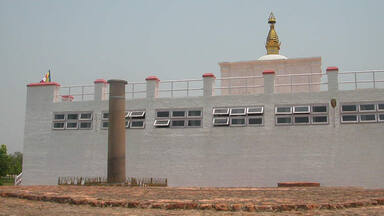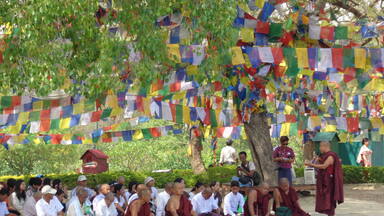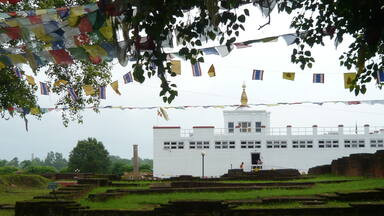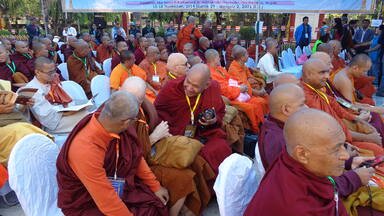Lumbini, the Birthplace of the Lord Buddha
Lumbini, the Birthplace of the Lord Buddha
Siddhartha Gautama, the Lord Buddha, was born in 623 B.C. in the famous gardens of Lumbini, which soon became a place of pilgrimage. Among the pilgrims was the Indian emperor Ashoka, who erected one of his commemorative pillars there. The site is now being developed as a Buddhist pilgrimage centre, where the archaeological remains associated with the birth of the Lord Buddha form a central feature.
Description is available under license CC-BY-SA IGO 3.0
Lumbini, lieu de naissance du Bouddha
Siddharta Gautama, le Bouddha, est né en 623 av. J.-C. dans les célèbres jardins de Lumbini et son lieu de naissance est devenu un lieu de pèlerinage. Parmi les pèlerins se trouvait l'empereur indien Asoka qui a fait édifier à cet endroit l'un de ses piliers commémoratifs. Le site est maintenant un foyer de pèlerinage centré sur les vestiges associés au début du bouddhisme et à la naissance du Bouddha.
Description is available under license CC-BY-SA IGO 3.0
لومبيني، مكان ولادة بوذا
ولد سيدهرتا غوتاما أي بوذا في العام 623 ق.م. في حدائق لومبيني الشهيرة التي أصبحت مكانًا للحج. وكان من بين الحجاج الامبراطور الهندي اسوكا الذي شيد في هذا المكان إحدى دعائمه التذكارية. ويُعتبر هذا الموقع اليوم مركزًا للحج يتضمَّن بشكلٍ أساسي الآثار المرتبطة ببداية البوذية و بولادة بوذا.
source: UNESCO/CPE
Description is available under license CC-BY-SA IGO 3.0
佛祖诞生地兰毗尼
释迦牟尼佛祖于公元前623年诞生于兰毗尼一座著名的花园,后来该处就成为朝圣之地。印度的阿育王也是朝拜者之一,并在此建立了一个他的纪念碑。这里现在已逐渐成为佛教徒的朝圣中心,以考古遗迹和佛祖诞生地为主要特色。
source: UNESCO/CPE
Description is available under license CC-BY-SA IGO 3.0
Лумбини, место рождения Будды
Сиддхартха Гаутама – великий Будда, был рожден в 623 г. до н.э в знаменитых садах Лумбини, ставших вскоре местом паломничества. Среди паломников был индийский император Ашока, который установил здесь одну из своих памятных колонн. Сейчас в Лумбини функционирует центр паломничества буддистов, где главная достопримечательность – археологические находки, ассоциируемые с рождением великого Будды.
source: UNESCO/CPE
Description is available under license CC-BY-SA IGO 3.0
Lumbini, lugar de nacimiento de Buda
Sidharta Gautama, Buda, nació el año 623 a.C. en los famosos jardines de Lumbini, que pronto se convertirían en un lugar de peregrinación. Un ilustre peregrino, el emperador indio Asoka, ordenó erigir en ellos uno de sus pilares conmemorativos. Hoy en día, este sitio sigue siendo un centro de peregrinación, en el que los vestigios arqueológicos vinculados al nacimiento de Buda y los comienzos del budismo constituyen uno de sus principales centros de interés.
source: UNESCO/CPE
Description is available under license CC-BY-SA IGO 3.0
仏陀の生誕地ルンビニ
釈迦は前623年ルンビニで生まれた。彼の生誕地は釈迦の生涯にちなむ四大霊場の一つとして仏教徒の巡礼の地となった。アショーカ王も即位20年目に巡礼し、ここに記念の石柱を建立した。7世紀玄奘はこの石柱が落雷で折れていたと記録している。1896年A・フューラーによって遺跡の発掘が行われ、現在は政府による公園整備が進んでいる。source: NFUAJ
Lumbini, geboorteplaats van de Boeddha
Siddhartha Gautama, de Boeddha, werd geboren in 623 voor Christus in de beroemde tuinen van Lumbini, gelegen in de zuidwestelijke Terai van Nepal. Lumbini werd al snel een bedevaartsoord. In 249 voor Christus maakte de vrome boeddhistische keizer Ashoka een pelgrimstocht naar deze stad en richtte er een van zijn herdenkingszuilen op. De plaats ontwikkelt zich nu tot een boeddhistisch bedevaartcentrum, waar de archeologische overblijfselen verbonden met de geboorte van de Boeddha een prominente plaats innemen. Lumbini behoort tot de meest heilige en kenmerkende plaatsen voor een van ’s werelds grootste religies.
Source: unesco.nl
Outstanding Universal Value
Brief synthesisThe Lord Buddha was born in 623 BC in the sacred area of Lumbini located in the Terai plains of southern Nepal, testified by the inscription on the pillar erected by the Mauryan Emperor Asoka in 249 BC. Lumbini is one of the holiest places of one of the world's great religions, and its remains contain important evidence about the nature of Buddhist pilgrimage centres from as early as the 3rd century BC.
The complex of structures within the archaeological conservation area includes the Shakya Tank; the remains within the Maya Devi Temple consisting of brick structures in a cross-wall system dating from the 3rd century BC to the present century and the sandstone Ashoka pillar with its Pali inscription in Brahmi script. Additionally there are the excavated remains of Buddhist viharas (monasteries) of the 3rd century BC to the 5th century AD and the remains of Buddhist stupas (memorial shrines) from the 3rd century BC to the 15th century AD. The site is now being developed as a Buddhist pilgrimage centre, where the archaeological remains associated with the birth of the Lord Buddha form a central feature.
Criterion (iii): As the birthplace of the Lord Buddha, testified by the inscription on the Asoka pillar, the sacred area in Lumbini is one of the most holy and significant places for one of the world’s great religions.
Criterion (vi): The archaeological remains of the Buddhist viharas (monasteries) and stupas (memorial shrines) from the 3rd century BC to the 15th century AD, provide important evidence about the nature of Buddhist pilgrimage centres from a very early period.
IntegrityThe integrity of Lumbini has been achieved by means of preserving the archaeological remains within the property boundary that give the property its Outstanding Universal Value. The significant attributes and elements of the property have been preserved. The buffer zone gives the property a further layer of protection. Further excavations of potential archaeological sites and appropriate protection of the archaeological remains are a high priority for the integrity of the property. The property boundary however does not include the entire archaeological site and various parts are found in the buffer zone. The entire property including the buffer zone is owned by the Government of Nepal and is being managed by the Lumbini Development Trust and therefore there is little threat of development or neglect. However the effects of industrial development in the region have been identified as a threat to the integrity of the property.
AuthenticityThe authenticity of the archaeological remains within the boundaries has been confirmed through a series of excavations since the discovery of the Asoka pillar in 1896. The remains of viharas, stupas and numerous layers of brick structures from the 3rd century BC to the present century at the site of the Maya Devi Temple are proof of Lumbini having been a centre of pilgrimage from early times. The archaeological remains require active conservation and monitoring to ensure that the impact of natural degradation, influence of humidity and the impact of the visitors are kept under control. The property continues to express its Outstanding Universal Value through its archaeological remains. The delicate balance must be maintained between conserving the archaeological vestiges of the property while providing for the pilgrims.
Protection and management requirementsThe property site is protected by the Ancient Monument Preservation Act 1956. The site management is carried out by the Lumbini Development Trust, an autonomous and non-profit making organization. The entire property is owned by the Government of Nepal. The property falls within the centre of the Master Plan area, the planning of which was initiated together with the United Nations and carried out by Prof. Kenzo Tange between 1972 and 1978.
The long-term challenges for the protection and management of the property are to control the impact of visitors, and natural impacts including humidity and the industrial development in the region. A Management Plan is in the process of being developed to ensure the long-term safeguarding of the archaeological vestiges of the property while allowing for the property to continue being visited by pilgrims and tourists from around the world.
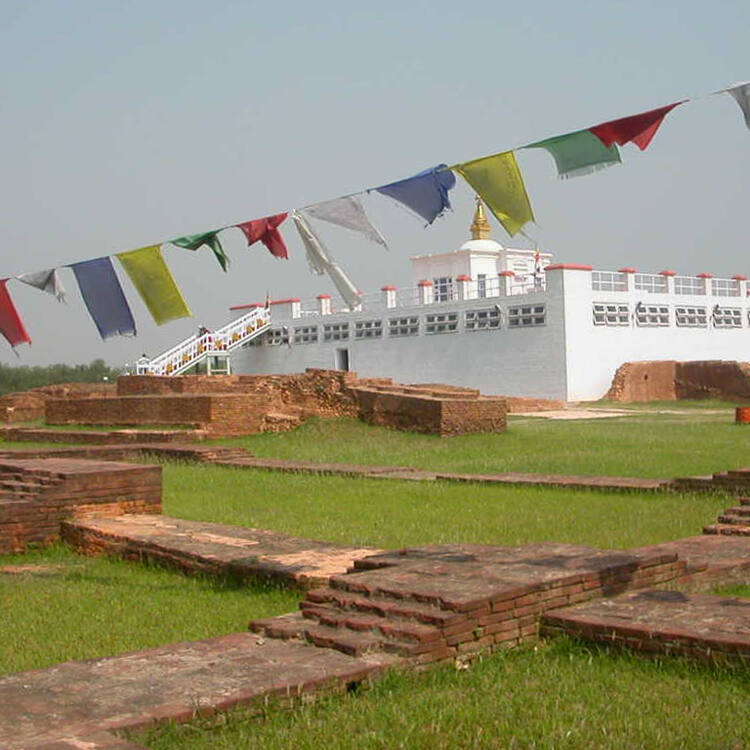
 View photos from OUR PLACE the World Heritage collection
View photos from OUR PLACE the World Heritage collection